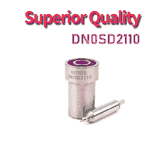Information injection-pump assembly
ZEXEL
101441-9750
1014419750
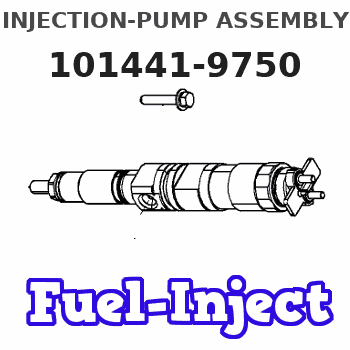
Rating:
Service parts 101441-9750 INJECTION-PUMP ASSEMBLY:
1.
_
6.
COUPLING PLATE
7.
COUPLING PLATE
8.
_
9.
_
11.
Nozzle and Holder
12.
Open Pre:MPa(Kqf/cm2)
11.8{120}
15.
NOZZLE SET
Include in #1:
101441-9750
as INJECTION-PUMP ASSEMBLY
Include in #2:
105856-5071
as _
Cross reference number
ZEXEL
101441-9750
1014419750
Zexel num
Bosch num
Firm num
Name
Calibration Data:
Adjustment conditions
Test oil
1404 Test oil ISO4113 or {SAEJ967d}
1404 Test oil ISO4113 or {SAEJ967d}
Test oil temperature
degC
40
40
45
Nozzle and nozzle holder
105780-8140
Bosch type code
EF8511/9A
Nozzle
105780-0000
Bosch type code
DN12SD12T
Nozzle holder
105780-2080
Bosch type code
EF8511/9
Opening pressure
MPa
17.2
Opening pressure
kgf/cm2
175
Injection pipe
Outer diameter - inner diameter - length (mm) mm 6-2-600
Outer diameter - inner diameter - length (mm) mm 6-2-600
Tester oil delivery pressure
kPa
157
157
157
Tester oil delivery pressure
kgf/cm2
1.6
1.6
1.6
Direction of rotation (viewed from drive side)
Left L
Left L
Injection timing adjustment
Direction of rotation (viewed from drive side)
Left L
Left L
Injection order
1-3-4-2
Pre-stroke
mm
2.25
2.2
2.3
Beginning of injection position
Drive side NO.1
Drive side NO.1
Difference between angles 1
Cal 1-3 deg. 90 89.5 90.5
Cal 1-3 deg. 90 89.5 90.5
Difference between angles 2
Cal 1-4 deg. 180 179.5 180.5
Cal 1-4 deg. 180 179.5 180.5
Difference between angles 3
Cyl.1-2 deg. 270 269.5 270.5
Cyl.1-2 deg. 270 269.5 270.5
Injection quantity adjustment
Adjusting point
A
Rack position
12.9
Pump speed
r/min
750
750
750
Average injection quantity
mm3/st.
39.3
37.7
40.9
Max. variation between cylinders
%
0
-4
4
Fixing the lever
*
Injection quantity adjustment_02
Adjusting point
B
Rack position
12
Pump speed
r/min
1300
1300
1300
Average injection quantity
mm3/st.
39.2
38.2
40.2
Max. variation between cylinders
%
0
-2.5
2.5
Basic
*
Fixing the lever
*
Injection quantity adjustment_03
Adjusting point
-
Rack position
9+-0.5
Pump speed
r/min
525
525
525
Average injection quantity
mm3/st.
9.5
8.4
10.6
Max. variation between cylinders
%
0
-14
14
Fixing the rack
*
Remarks
Adjust only variation between cylinders; adjust governor according to governor specifications.
Adjust only variation between cylinders; adjust governor according to governor specifications.
Timer adjustment
Pump speed
r/min
500+-50
Advance angle
deg.
0
0
0
Remarks
Start
Start
Timer adjustment_02
Pump speed
r/min
800
Advance angle
deg.
1
0.5
1.5
Timer adjustment_03
Pump speed
r/min
1050
Advance angle
deg.
2
1.2
2.7
Timer adjustment_04
Pump speed
r/min
1300
Advance angle
deg.
3.3
2.8
3.8
Timer adjustment_05
Pump speed
r/min
-
Advance angle
deg.
6
6
6
Remarks
Measure the actual speed, stop
Measure the actual speed, stop
Test data Ex:
Governor adjustment
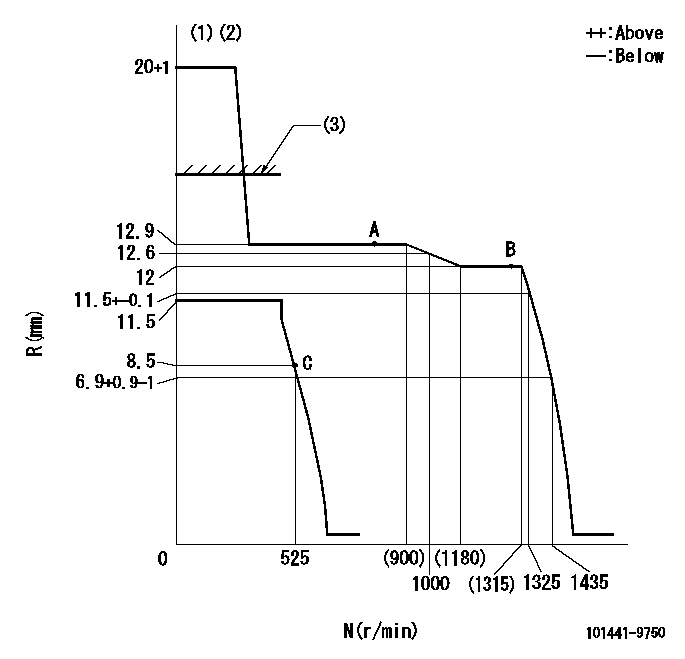
N:Pump speed
R:Rack position (mm)
(1)Target notch: K
(2)Tolerances for racks not indicated: +-0.05mm.
(3)RACK CAP: R1
----------
K=4 R1=(17.5)mm
----------
----------
K=4 R1=(17.5)mm
----------
Speed control lever angle
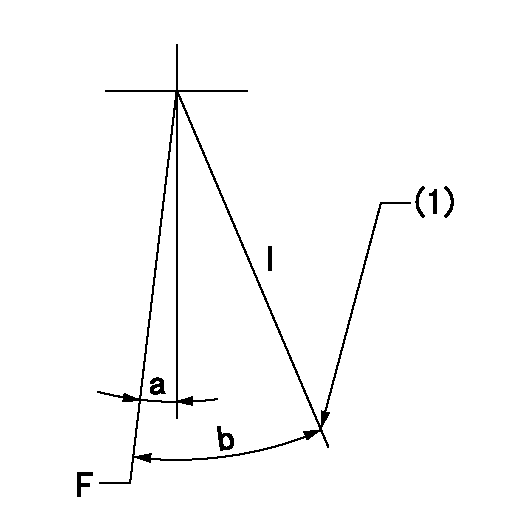
F:Full speed
I:Idle
(1)Stopper bolt setting
----------
----------
a=4deg+-5deg b=24deg+-5deg
----------
----------
a=4deg+-5deg b=24deg+-5deg
Stop lever angle
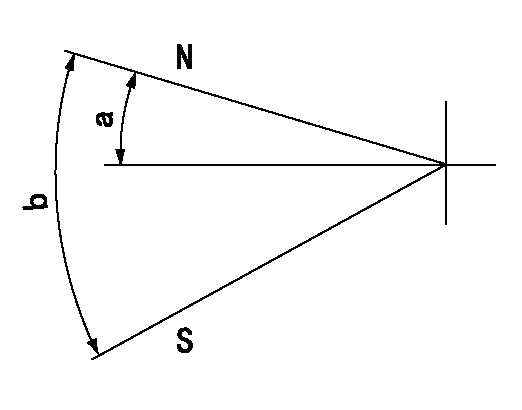
N:Pump normal
S:Stop the pump.
----------
----------
a=19deg+-5deg b=53deg+-5deg
----------
----------
a=19deg+-5deg b=53deg+-5deg
Timing setting
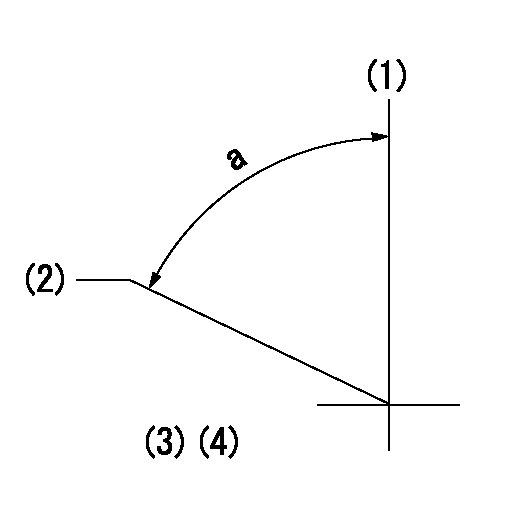
(1)Pump vertical direction
(2)Gear mark Z for the No. 4 cylinder's beginning of injection
(3)B.T.D.C.: aa
(4)-
----------
aa=14deg
----------
a=(60deg)
----------
aa=14deg
----------
a=(60deg)
Information:
Test Procedure
System Operation
A thermocouple is a temperature sensor. The thermocouple consists of two different metals. The metals are joined together at one end. A small voltage is produced when the junction is heated. The change in voltage is interpreted by an electronic device in order to determine a change in temperature. The MMS uses K type thermocouples. The K type thermocouples have ranges from -200 °C (-328 °F)to 1260 °C (2300 °F). This temperature range corresponds to a voltage range of negative 5.9 mV to 51.0 mV.The signal is used in order to trigger alarms and the signal is used in order to display the parameter.
Illustration 1 g00563634
Diagram of the thermocouple
Illustration 2 g00563637
Schematic of the thermocoupleFunctional Test
Check the electrical connectors and check the wiring.
Bodily contact with electrical potential can cause bodily injury or death.To avoid the possibility of injury or death, ensure that the main power supply has been disconnected before performing any maintenance or removing any modules.
Disconnect the power supply.
Check the electrical connectors and check the wiring for damage or bad connections.
Verify that all modules are properly seated.
Verify the status of the LED on the SLC 5/04.The results of the preceding procedure are in the following list:
All of the components are fully installed. All of the components are free of corrosion. All of the components are free of damage. All of the modules are properly seated. Stop.
The components are not fully installed. The components are not free of corrosion. The components are damaged. All of the modules are not properly seated. Repair the component. Verify that the repair resolves the problem. STOP.
System Operation
A thermocouple is a temperature sensor. The thermocouple consists of two different metals. The metals are joined together at one end. A small voltage is produced when the junction is heated. The change in voltage is interpreted by an electronic device in order to determine a change in temperature. The MMS uses K type thermocouples. The K type thermocouples have ranges from -200 °C (-328 °F)to 1260 °C (2300 °F). This temperature range corresponds to a voltage range of negative 5.9 mV to 51.0 mV.The signal is used in order to trigger alarms and the signal is used in order to display the parameter.
Illustration 1 g00563634
Diagram of the thermocouple
Illustration 2 g00563637
Schematic of the thermocoupleFunctional Test
Check the electrical connectors and check the wiring.
Bodily contact with electrical potential can cause bodily injury or death.To avoid the possibility of injury or death, ensure that the main power supply has been disconnected before performing any maintenance or removing any modules.
Disconnect the power supply.
Check the electrical connectors and check the wiring for damage or bad connections.
Verify that all modules are properly seated.
Verify the status of the LED on the SLC 5/04.The results of the preceding procedure are in the following list:
All of the components are fully installed. All of the components are free of corrosion. All of the components are free of damage. All of the modules are properly seated. Stop.
The components are not fully installed. The components are not free of corrosion. The components are damaged. All of the modules are not properly seated. Repair the component. Verify that the repair resolves the problem. STOP.
